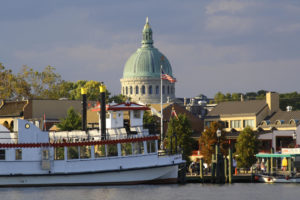
This month we travel to the birthplace of religious freedom in America, the state of Maryland. Formed by George Calvert in the early 17th Century, the state was intended as a refuge for persecuted Catholics from England. George Calvert was the first Lord of Baltimore and the first English proprietor of the then-Maryland colonial grant. Maryland was the seventh state to ratify the U.S. Constitution, and played a pivotal role in the founding of Washington D.C., which was established on land donated by the state.
Mid-Atlantic Maryland is defined by its abundant waterways and coastlines on the Chesapeake Bay and Atlantic Ocean. Its largest city, Baltimore, has a history as a major seaport, and is also home to such tourist attractions as the National Aquarium and the Maryland Science Center.
Maryland possesses a variety of topography within its borders, contributing to its nickname- America in Miniature. Sandy dunes and seagrass paint the landscape in the east. Low marshlands with lots of wildlife are situated next to the Chesapeake Bay. Gently rolling hills full of Oak forests blanket the piedmont region. To the west, you can find pine groves amongst the mountains.
Business Climate
The state as a whole is heavily industrialized, with a booming economy, and influential technology centers. Its computer industries are some of the most sophisticated in the United States, and the federal government has invested heavily in the area. Maryland is home to several large military bases, including Joint Base Andrews where Air Force 1 is kept, and scores of high level government jobs.
Maryland’s economy benefits from the state’s proximity to the federal government in Washington D.C., with an emphasis on technical and administrative work for the defense/ aerospace industry and bio-research laboratories. Residents of Maryland also staff satellite government headquarters in the suburban or exurban Baltimore/ Washington area.
Maryland is a major center for life sciences and research and development. With more than 400 biotechnology companies located in the state, it is the fourth-largest area in this field in the country. Some institutions and government agencies that specialize in research and development include the Johns Hopkins University, the Goddard Space Flight Center, the National Institutes of Health (NIH), the Walter Reed National Military Medical Center and the federal Food and Drug Administration (FDA).
Commercial fishing is a well-known industry in Maryland, centered around the Chesapeake Bay, but also including activity off the short Atlantic seacoast. The largest catches by species are the blue crab, oysters, striped bass, and menhaden. The Bay also has an abundant supply of waterfowl in its wildlife refuges, which supports the tourism sector of sportsmen.
Tax Climate
Maryland imposes five income tax brackets, ranging from 2 to 6.25 percent of personal income. The top individual income tax rate is 5.75%. The state and local tax burden is 10.9%, which ranks 7th highest in the nation. The city of Baltimore and the state’s 23 counties levy local “piggyback” income taxes at rates between 1.25 and 3.2 percent of the state’s taxable income. The top combined income tax bracket of 9.45% is the fifth highest combined state and local income tax rates in the country, behind New York City’s 11.35%, California’s 10.3%, Rhode Island’s 9.9%, and Vermont’s 9.5%.
The top corporate income tax rate is 8.25%, ranking 42nd among all the states in the nation that levy a corporate income tax. Maryland’s state sales tax is 6%. With the presence of many technology and bioscience companies in the state, Maryland proves to be a popular destination for other companies to sell their software products into the state. Prewritten software that is downloaded electronically is taxable. Software-as-a-Service is not taxable. Lastly, digital products are also not taxed in the state.
All real property in Maryland is subject to property tax. Property tax rates vary widely. Generally, properties that are owned and used by religious, charitable, or educational organizations or property owned by the federal, state or local governments are exempt. However, no restrictions or limitations on property taxes are imposed by the state, meaning cities and counties can set tax rates at the level they deem necessary to fund governmental services. These local rates can increase, decrease or remain the same from year to year. If the proposed tax rate increases the total property tax revenues, the governing body must advertise that fact and hold a public hearing on the new rate. This is called the Constant Yield Tax Rate process.
Other taxes that are important to the citizens are the gasoline and cigarette taxes. The state gasoline tax is 33.5 cents per gallon, which ranks 15th highest in the nation, and the state cigarette tax rate is $2 per 20-pack. This ranks 12th highest in the nation.
Tax Incentives and Credits
Businesses in Maryland may be able to take advantage of several tax credits. Some of these include:
Biotechnology Investment Incentive Tax Credit- An individual or business may be allowed a tax credit of up to 50% of an eligible investment in a qualified Maryland biotechnology company (QMBC), up to $250,000. If the QMBC is located in Allegany, Dorechester, Garret, or Somerset Counties, an individual may be allowed a tax credit of up to 75% of an eligible investment, up to $500,000. The investor, after making the proposed investment, cannot own more than 25% of the biotechnology company. For an introduction to the qualifications on the credit, click here.
Health Enterprise Zone Hiring Tax Credit- A “Health Enterprise Zone Employer” means a HEZ practitioner, a for-profit entity, or a nonprofit entity that employs qualified employees and provides health care services in an HEZ. An HEZ employer may be eligible for a refundable income tax credit based on wages paid to qualified employees. For more information on this credit, click here.
Research and Development Tax Credits- Businesses that invest in research and development in Maryland may be entitled to an income tax credit. Sole proprietorships, corporations and pass-through entities, such as partnerships, subchapter S corporations, limited liability companies and business trusts may claim the tax credit. Research and development tax credits certified after December 15, 2012 are refundable for a “small business” to the extent that the tax credits exceed the income tax liability for that taxable year. A “small business” is defined as a for-profit corporation, limited liability company, partnership or sole proprietorship with net book value assets totaling at the beginning or the end of the tax year for which that Maryland qualified research and development expenses are incurred, as reported on the balance sheet, less than $5 million. The credit may be taken against corporate income tax or the state portion of personal income tax. For more information on this credit, click here.
Our team at Miles Consulting Group is always available to discuss the specifics of your situation, whether in Maryland or other U.S. States, and help you navigate the complex tax structures arising from multistate operations. Call us to help you achieve the best tax efficiencies.
Random Facts
- Fort McHenry is home to the U.S. National Anthem, which sits at the mouth of Baltimore’s Inner Harbor.
- Baltimore City is the eighth largest seaport in the country.
- Maryland’s Mount Clare Station, built in Baltimore in 1830, was the first railroad station in the country.
- Maryland is famous for great seafood, especially crabs. During lunch hour on Maryland’s Chesapeake Bay, vendors sell almost as many crabcakes as hot dogs and hamburgers combined.
- Some notable athletes that came out of Maryland include Cal Ripken Jr., Babe Ruth, Frank Robinson, Ray Lewis and Michael Phelps.














